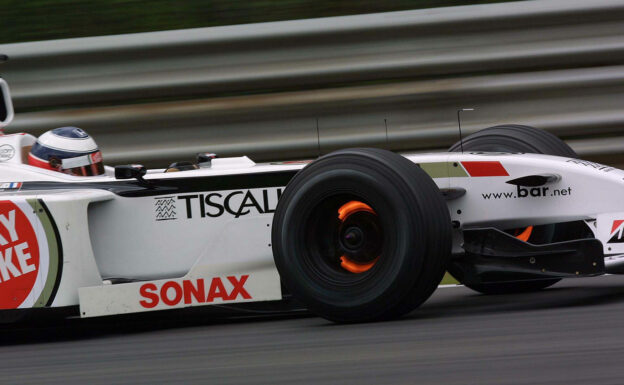What are F1 inventions on road cars?

The pinnacle of Motorsport, Formula 1 racing was born in 1950. The first race was the British Grand Prix driven at Silverstone on the 13th of May.
In the 68 years the sport exists a lot of inventions are done to make the cars faster and the sport more safe. Until the day that Ayrton Senna died more then 45 F1 drivers died in their race seat. Apart of engine tuning and tyre development many inventions came through to our normal road cars.
Formula 1 inventions
Inventions that are done in Formula 1 and that also got on our cars of today are:
- disc brakes
- active suspension
- sequential gearbox
- flappy paddle gearbox
- aerodynamics
- KERS
- steering wheel functions
- carbon fiber
- single wheelnut
- rear-view mirrors
Disc Brakes
Metal disc brakes were already used on war-craft like planes and tanks in the 1930's. The first use of disc brakes in Formula one was in the 1951 season. BRM used it on the Type 15s Formula 1 car. 2 years later in 1953 Dunlop disc brakes were fitted on the first road car. This was the Austin-Healy 100S which also had an aluminium body and was the first car ever that had disc brakes on all 4 wheels.
Formula 1 cars of today don't use metal disc brakes anymore and made a huge evolution. The discs are made of reinforced carbon and are inspired by aircraft braking systems. The carbon discs have a working temperatures between 350ºC/1.000ºC. Some road hyper cars also have carbon brake discs. But because of the high working temperature they are not well suited for road cars.
The carbon disks only weigh 1.2 kilo's while a normal cast iron disc of a Rang Rover weighs 14 kilo's. The F1 discs only have lifespan of 800 km, while the road car disc can be used for around 80.000 km.
Sequential Gearbox
In 1986 the Williams F1 team started working on the idea of developing a sequential gearbox. In those days the drivers didn't have a flappy paddle gearbox behind the steering wheel, but they had to use a lever with one hand and steer with the other hand. In circuit like Monaco where you have change gear a lot, this was a very difficult task.
With a sequential gearbox you cannot change gear from 5 to 2 like you normally do with a road car gearbox. Thanks to Ian Anderson who was chief mechanic at Williams those days, they could built the faster shifting gearbox (30-50 ms) in a few weeks.
The first use of the a sequential gearbox with flappy paddles was in the 1991 F1 season by Williams. In the first four races they had reliability problems with the gearbox, that probably have costs them the championship.
Not a lot of roadcars have a sequential gearbox. You can find one in some high performance cars, like the Atom, Caterham. You can also find them in a lot of cars that have an automatic transmission, to use the manual mode.
Carbon Fiber
In 1981 it was car designer John Bernard who made the first self supporting chassis from carbon fibre for McLaren. The McLaren MP4 was also the first car of the Ron Dennis era. The use of carbon fiber had big advantages. The material is about 3,5 times stronger than Steel and 5 times lighter, but much more expansive. The concept was copied by all other F1 teams in no-time.
A lot (expensive) cars of today also use carbon fiber. Here is list of cars that are the are made of carbon fiber:
- Alfa Romeo 4C
- Jaguar XJR-15
- McLaren SLR
- Pagani Zonda
- Porsche Carrera GT
✅ Check out more posts with related topics:













LAST 3 F1 Fan COMMENTS